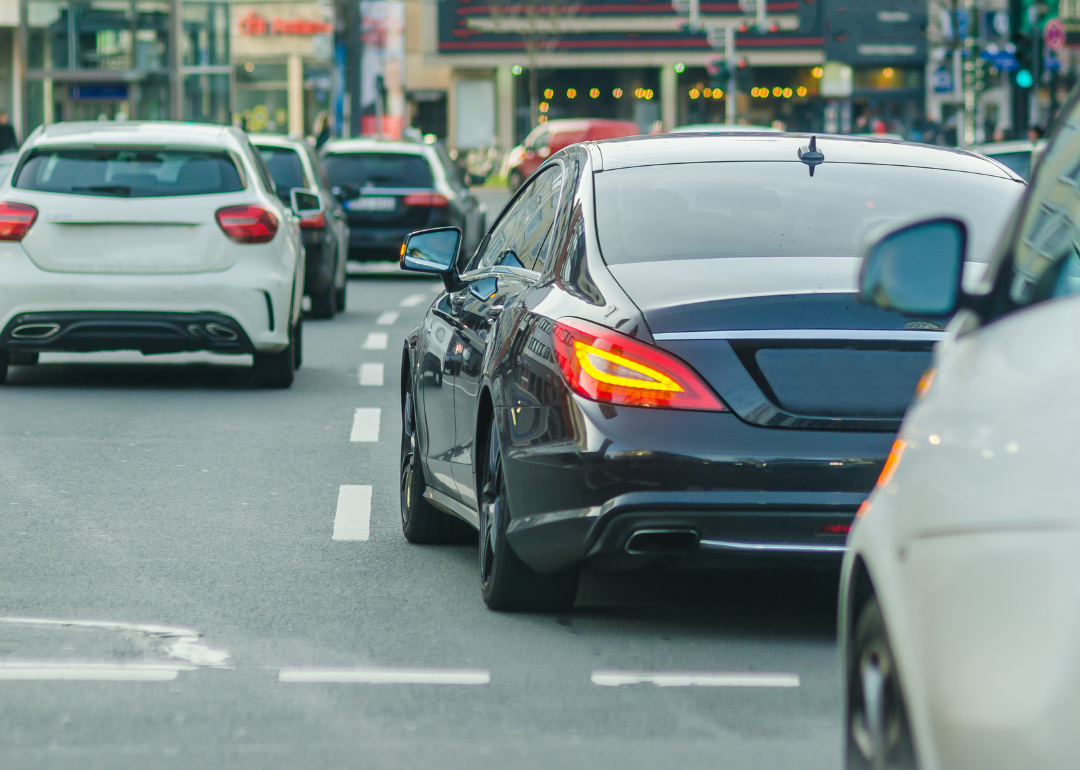
This story was produced by CheapInsurance.com and reviewed and distributed by Stacker Media.
Does lane changing get you there faster?
In the hustle and bustle of modern life, we're always looking for ways to save time. And when it comes to driving, one common belief is that changing lanes can help you get to your destination faster. But is this really true? CheapInsurance.com takes a closer look at multiple studies that address the practice and impact of frequent lane changing.
A 2021 study by the AAA Foundation for Traffic Safety found that 25% of drivers admitted to changing lanes more than three times per mile. This alarming statistic suggests that a substantial portion of motorists are willing to prioritize perceived time savings over their own safety and that of others.
Moreover, the aforementioned study found that while nine in ten drivers felt driving aggressively by switching lanes quickly and/or very close behind another car to be very or extremely dangerous, about a quarter of drivers admitted to having done so at least once in the past 30 days. This extreme level of lane changing further highlights the prevalence of this risky behavior and its potential to contribute to accidents.
The reasons behind frequent lane changing are multifaceted. Some drivers may believe it allows them to gain an advantage in traffic, while others may perceive it as a way to maintain a consistent speed. However, regardless of the perceived benefit, the risks associated with frequent lane changing far outweigh any potential gains.
Does lane changing really matter?
The allure of lane changing as a time-saving strategy has long captivated drivers, prompting numerous studies to delve into its effectiveness in reducing travel time. While some research suggests that lane changing can offer marginal time savings, particularly in heavy traffic conditions, the consensus among experts remains that its overall impact on travel time is negligible.
One notable study conducted by researchers at the University of Toronto examined the impact of lane changing on travel time in heavy traffic conditions. The study employed a sophisticated simulation model to assess the impact of lane changing on travel time in heavy traffic scenarios. Their findings, published in the American Journal of Physics, indicated that while lane changing could indeed reduce travel time, the savings were minimal, amounting to only 2%, suggesting that its effectiveness in saving time may be limited.
In contrast, a study by the Federal Highway Administration (FHWA) investigated the effects of lane changing on travel time across various traffic conditions, including both heavy and light traffic scenarios. This study, conducted over a broader range of traffic conditions, reached similar conclusions. Their findings, published in the Traffic Flow Characteristics report, indicated that lane changing had no significant impact on travel time, regardless of whether traffic was heavy or light. This suggests that the time-saving benefits of lane changing may not be consistently realized across different traffic conditions.
Taken together, these findings suggest that the time-saving benefits of lane changing may be overstated, particularly when considering the potential safety risks associated with this maneuver.
Considering the safety implications
While the potential time savings offered by lane changing may be negligible, the safety risks associated with this maneuver are far more substantial. Frequent lane changing increases the risk of accidents, as drivers may not have enough time to react to changing conditions in adjacent lanes.
The 2021 AAA Foundation for Traffic Safety study found that drivers who changed lanes frequently were twice as likely to be involved in an accident as those who changed lanes less often.
In addition to the increased risk of accidents, frequent lane changing can also lead to more moving violations and traffic tickets. Drivers who are constantly weaving in and out of traffic are more likely to be caught by police officers for speeding, running red lights, and other infractions.
Safety concerns of frequent lane changing
While frequent lane changing may seem like a harmless way to save a few minutes, the potential safety risks and legal consequences far outweigh any perceived benefits. By avoiding frequent lane changes and adopting a more cautious and predictable driving style, motorists can significantly reduce their risk of accidents and traffic violations, making our roads safer for everyone.
Moving violations and lane changing: A risky combination
The thrill of maneuvering through traffic might provide a sense of control, but frequent lane changing comes with a hefty price tag – an increased risk of moving violations and traffic tickets. Drivers who constantly dart in and out of lanes are more likely to catch the attention of law enforcement officials for speeding, running red lights, and other traffic infractions.
The increased likelihood of moving violations associated with frequent lane changing stems from several factors. Firstly, drivers who constantly switch lanes may be more inclined to exceed the speed limit in an attempt to gain an advantage over other vehicles. This disregard for speed limits puts not only themselves but also other road users at risk of accidents.
Secondly, frequent lane changing often involves abrupt and unexpected maneuvers, which can lead to drivers running red lights or failing to yield at intersections. These reckless actions increase the risk of collisions and jeopardize the safety of pedestrians and fellow motorists.
Thirdly, drivers who engage in frequent lane changing may be more likely to engage in distracted driving behaviors, such as using their phones or fiddling with their car's controls. These distractions can further impair their ability to adhere to traffic rules and increase the risk of moving violations.
In addition to the potential for moving violations, frequent lane changing can also lead to traffic tickets for other infractions, such as unsafe passing, failing to signal lane changes, and following too closely.
How frequent lane-changing and its associated driving behaviors can affect your car insurance coverage
Frequent lane changing is often associated with these other driving behaviors that can result in accidents, moving violations, or points on your driving record, all of which could lead to increased premiums or loss of insurance:
Moving violations and traffic tickets: A major red flag for insurance companies, they indicate a higher risk of accidents and can lead to higher insurance premiums. Multiple violations or serious offenses can result in policy cancellation or non-renewal.
Speeding: According to a study by the Insurance Research Council, drivers with a speeding violation on their record can expect to pay an average of 24% more for car insurance.
Unsafe passing: Insurance companies view unsafe passing as reckless driving behavior that significantly increases the risk of accidents. As a result, a history of unsafe passing violations can lead to higher insurance premiums or policy non-renewal.
Failing to signal lane changes: Insurance companies view this as negligent driving behavior that can lead to confusion and accidents and thus can result in increased premiums or policy non-renewal.
Following too closely: Also known as tailgating, this driving behavior increases the risk of rear-end collisions. Insurance companies view tailgating as negligent behavior that demonstrates a lack of caution and respect for other road users.
At-fault accidents: Insurance companies view at-fault accidents as a clear indication of a driver's risk profile. Each at-fault accident can lead to a substantial increase in insurance premiums, and multiple at-fault accidents may result in policy cancellation or non-renewal
In conclusion, while frequent lane changing may seem like a harmless way to save a few minutes, the potential legal consequences far outweigh any perceived benefits. By avoiding frequent lane changes and adopting a more cautious and law-abiding driving style, motorists can significantly reduce their risk of moving violations and traffic tickets, making our roads safer for everyone.



